Читать книгу Health Communication Theory - Группа авторов - Страница 40
Narrative Problematics
ОглавлениеIn their seminal collection of health and illness narratives, Harter et al. (2005) advanced a typology of what they consider core dimensions – or vital problematics (i.e. assumptions) – of narrative theorizing that are pervasive but often unarticulated in the way scholars do narrative work. First, the problematic of knowing and being foregrounds how individuals narratively co‐construct and understand personal and social life. As one example, Yamasaki and Hovick (2015) revealed how African American older adults characterize their understandings of health‐related conditions from storied family histories and then rationalize their motivations and constraints for sharing that information with current family members. Second, the problematic of continuity and disruption, which “concerns disorder and the human desire for coherence” (Harter et al. 2005, p. 14), describes how storytellers construct and weigh “the past/present/future flow of continuity and disruption to give force to some understanding of the distinction between ‘now’ and ‘then’” (pp. 15–16). To illustrate, Pangborn (2019) poignantly demonstrated how teenagers at a family bereavement camp rely upon aesthetic and embodied narrative experiences to reject confining scripts for “appropriate” grief, acknowledge the value of their perspectives, and reengage in life in affirming ways.
Next, the problematic of creativity and constraint “foregrounds the human struggle to be individuated (i.e. assert creativity) and still identify with a group (i.e. respond to social and institutional constraints),” emphasizing connections between the personal and cultural (Harter et al. 2005, p. 19). Health communication scholars have engaged this problematic in studies that explore how “narratives emerge as contested terrains, open to challenge by those who seek to reshape perceptions of health issues and construct alternate narratives” (Harter et al. 2005, p. 23), including embodied, aesthetic stories that transform meanings of age (e.g. Sharf 2017; Yamasaki 2014), disability (e.g. Harter et al. 2006; Quinlan and Harter 2010), and baby loss (e.g. Willer 2016; Willer et al. 2019), among others. Finally, the problematic of the partial and indeterminate recognizes that the nature of narrative knowledge is always situated and shifting: “People live stories, and in the living of these stories, reaffirm them, modify them, and create new ones” (Harter et al. 2005, p. 27).
